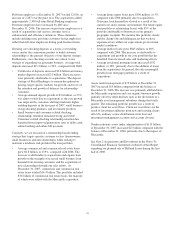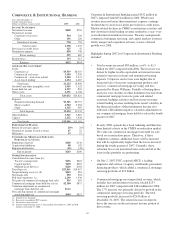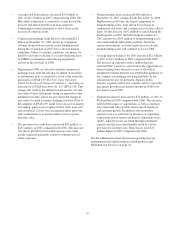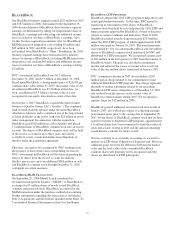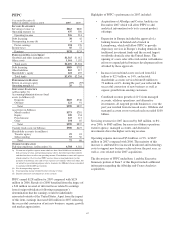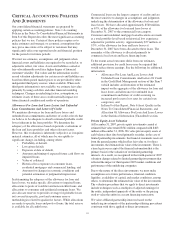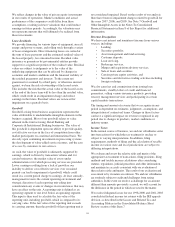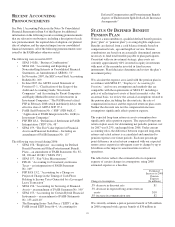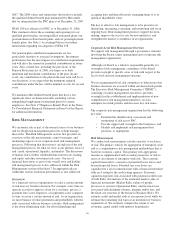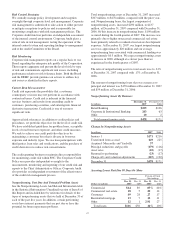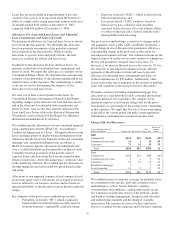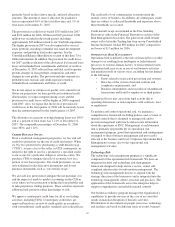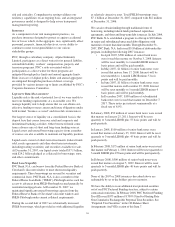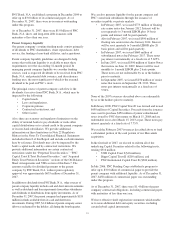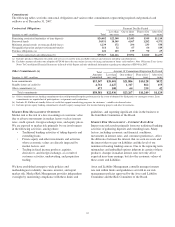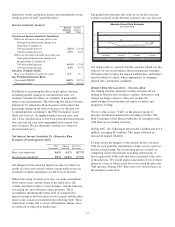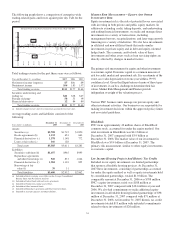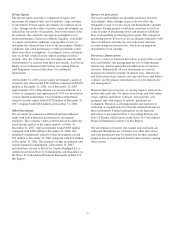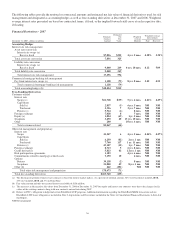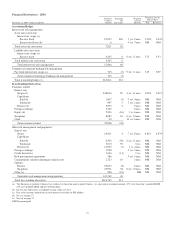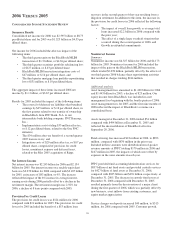PNC Bank 2007 Annual Report Download - page 53
Download and view the complete annual report
Please find page 53 of the 2007 PNC Bank annual report below. You can navigate through the pages in the report by either clicking on the pages listed below, or by using the keyword search tool below to find specific information within the annual report.
Loans that are not included in nonperforming or past due
categories but cause us to be uncertain about the borrower’s
ability to comply with existing repayment terms over the next
six months totaled $134 million at December 31, 2007,
compared with $41 million at December 31, 2006.
Allowances For Loan And Lease Losses And Unfunded
Loan Commitments And Letters Of Credit
We maintain an allowance for loan and lease losses to absorb
losses from the loan portfolio. We determine the allowance
based on quarterly assessments of the probable estimated
losses inherent in the loan portfolio. While we make
allocations to specific loans and pools of loans, the total
reserve is available for all loan and lease losses.
In addition to the allowance for loan and lease losses, we
maintain an allowance for unfunded loan commitments and
letters of credit. We report this allowance as a liability on our
Consolidated Balance Sheet. We determine this amount using
estimates of the probability of the ultimate funding and losses
related to those credit exposures. This methodology is similar
to the one we use for determining the adequacy of our
allowance for loan and lease losses.
We refer you to Note 6 Asset Quality in the Notes To
Consolidated Financial Statements in Item 8 of this Report
regarding changes in the allowance for loan and lease losses
and in the allowance for unfunded loan commitments and
letters of credit. Also see the Allocation Of Allowance For
Loan And Lease Losses table in the Statistical Information
(Unaudited) section of Item 8 of this Report for additional
information included herein by reference.
We establish specific allowances for loans considered impaired
using a method prescribed by SFAS 114, “Accounting by
Creditors for Impairment of a Loan.” All impaired loans except
leases and large groups of smaller-balance homogeneous loans
which may include but are not limited to credit card, residential
mortgage, and consumer installment loans are subject to
SFAS 114 analysis. Specific allowances for individual loans
over a set dollar threshold are determined by our Special Asset
Committee based on an analysis of the present value of
expected future cash flows from the loans discounted at their
effective interest rate, observable market price, or the fair value
of the underlying collateral. We establish specific allowance on
all other impaired loans based on the loss given default credit
risk rating.
Allocations to non-impaired commercial and commercial real
estate loans (pool reserve allocations) are assigned to pools of
loans as defined by our business structure and are based on
internal probability of default and loss given default credit risk
ratings.
Key elements of the pool reserve methodology include:
• Probability of default (“PD”), which is primarily
based on historical default analyses and is derived
from the borrower’s internal PD credit risk rating;
• Exposure at default (“EAD”), which is derived from
historical default data; and
• Loss given default (“LGD”), which is based on
historical loss data, collateral value and other
structural factors that may affect our ultimate ability
to collect on the loan and is derived from the loan’s
internal LGD credit risk rating.
Our pool reserve methodology is sensitive to changes in key
risk parameters such as PDs, LGDs and EADs. In general, a
given change in any of the major risk parameters will have a
corresponding change in the pool reserve allocations for
non-impaired commercial loans. Our commercial loans are the
largest category of credits and are most sensitive to changes in
the key risk parameters and pool reserve loss rates. To
illustrate, if we increase the pool reserve loss rates by 5% for
all categories of non-impaired commercial loans, then the
aggregate of the allowance for loan and lease losses and
allowance for unfunded loan commitments and letters of
credit would increase by $39 million. Additionally, other
factors such as the rate of migration in the severity of problem
loans will contribute to the final pool reserve allocations.
We make consumer (including residential mortgage) loan
allocations at a total portfolio level by consumer product line
based on historical loss experience. We compute a four-
quarter average loss rate from net charge-offs for the prior
four quarters as a percentage of the average loans outstanding
in those quarters. We apply this loss rate to loans outstanding
at the end of the current period and make certain qualitative
adjustments to determine the consumer loan allocation.
Charge-Offs And Recoveries
Year ended December 31
Dollars in millions Charge-offs Recoveries
Net
Charge-offs
Percent of
Average
Loans
2007
Commercial $156 $30 $126 .49%
Commercial real estate 16 1 15 .20
Consumer 73 14 59 .33
Total $245 $45 $200 .32
2006
Commercial $108 $19 $89 .44%
Commercial real estate 3 1 2 .06
Consumer 52 15 37 .23
Residential mortgage 3 3 .04
Lease financing 14 5 9 .32
Total $180 $40 $140 .28
We establish reserves to provide coverage for probable losses
not considered in the specific, pool and consumer reserve
methodologies, such as, but not limited to, industry
concentrations and conditions, credit quality trends, recent
loss experience in particular sectors of the portfolio, ability
and depth of lending management, changes in risk selection
and underwriting standards and the timing of available
information. The amount of reserves for these qualitative
factors is assigned to loan categories and to business segments
48


